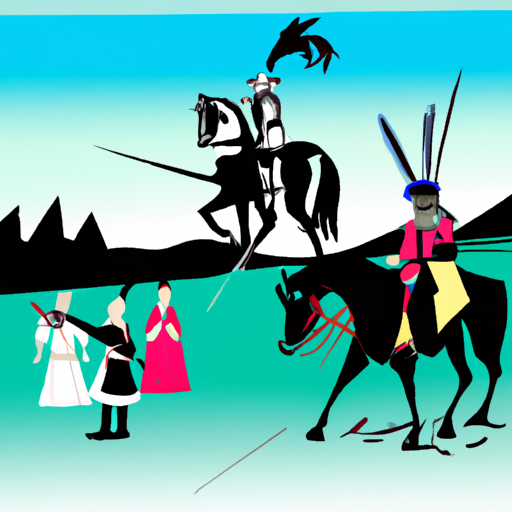A Historical Look at the Number of Muslims in China
Unearth the enigma of Muslims in China and discover the amount that have existed throughout the ages! Delve into a past shrouded in obscurity, and uncover the secrets of an ancient culture. Unravel the mysteries surrounding this overlooked population, and explore their impact on Chinese history.

For centuries, Muslims have been a part of Chinese history, their presence dating back to the Tang Dynasty (618-907 CE). Despite facing numerous challenges and being viewed as outsiders by some, they have managed to preserve their faith and culture. During the Tang Dynasty, traders from Central Asia arrived in China and were welcomed by the ruling dynasty. Later on, during the Yuan Dynasty (1271-1368 CE), Genghis Khan’s grandson Kublai Khan encouraged more Muslims from Central Asia and Persia to settle in China. This influx of people brought with them new ideas and customs that had a lasting impact on Chinese society.
In modern times, Muslims continue to make significant contributions to Chinese culture. They are renowned for their knowledge of Islamic studies and teachings, while also bringing forth new foods, music, art, and literature into mainstream society. It is therefore clear that this unique population has played an integral role in shaping our world today – one that should not be forgotten or overlooked.
.
Introduction

A bewildering story, stretching back centuries, of Muslim presence in China has been unfolding. From the seventh century, when Arabian traders and merchants began their dealings with Chinese counterparts along the Silk Road, a Muslim presence was established across the nation – particularly in the western provinces such as Xinjiang. Current estimates from Chinese authorities suggest that more than 21 million Muslims now reside in China, amounting to a proportion of 1.5% of the total population; and this figure is expected to rise further still as people move to China seeking economic opportunities.
– Historical Overview of the Muslim Population in China
Throughout the ages, Muslims have been a significant part of Chinese society, with their presence stretching back to the 7th century when Arab traders first came to the country. During the Yuan Dynasty (1271-1368), they even formed an important part of the ruling class and were granted notable privileges. This period saw a dramatic increase in Muslim immigration to China, and by the 15th century, they had spread throughout many regions.
However, during the Qing Dynasty (1644-1911), Muslims experienced much persecution and restrictions on religious practice, along with forced relocation and massacres in some areas. Despite this, many still managed to keep their faith alive through these hard times. Additionally, there was also a large influx of Hui people from Central Asia at this time as well.
Today, Islam is still a vital part of Chinese culture and there are more than 20 million Muslims living in China – making up less than 2% of its total population. Though they may experience discrimination or limitations on religious practice in certain parts of the nation, most are able to coexist peacefully with their non-Muslim neighbors.
The history of Muslim populations in China is one that speaks volumes about their strength and determination despite centuries of oppression and prejudice. Their influence has left an undeniable mark on Chinese culture that will continue to shape its future for years to come.
– How the Mongol Empire Influenced Muslim Migration to China
The mighty Mongol Empire, established in the 13th century, had an immense effect on the Muslim movement to China. Throughout its reign, it was well-known for its expansion and subjugation of wide-ranging territories, including parts of modern-day China. As they conquered these lands, they brought with them their own spiritual convictions and customs, which included Islam.
The ever-growing Mongol Empire drew in more Muslims to China as they embraced those who sought to join their realm and allowed them to practice their faith without obstruction. This provided a motivating force for those searching for a safe haven to live and exercise their religion. Moreover, the Mongol rulers were receptive of diverse beliefs and cultures, which further encouraged Muslim migration into China.
The Mongols also acted as catalysts in trading between East Asia and the Middle East. This enabled goods from both areas to be exchanged along with ideas and culture. This increased contact between Chinese Muslims and people from other countries with Islamic backgrounds, further encouraging Muslim relocation into China.
In addition to helping economic exchange between East Asia and the Middle East, the Mongol Empire also offered military protection for Chinese Muslims against foreign invaders such as the Ming Dynasty’s forces during the 14th century CE. This helped guarantee that Chinese Muslims could continue living in harmony without fear of maltreatment or discrimination based on their faith.
To sum up, it is evident that the Mongol Empire had a major impact on Muslim migration into China throughout its history. With its tolerant policies towards different religions and cultures as well as its promotion of trade between East Asia and the Middle East, it provided an environment where Chinese Muslims could thrive without fear of persecution or discrimination based on their faith.
– The Impact of the Cultural Revolution on Chinese Muslims
A period of tremendous upheaval and change, the Cultural Revolution of 1966 to 1976 had a far-reaching effect on Chinese Muslims and their culture. As part of a campaign to rid the nation of religious influences, mosques were closed or destroyed, Islamic schools were shut down, religious activities were prohibited, and Muslim leaders were persecuted. This meant that many Chinese Muslims saw a significant decrease in their religious liberty and cultural identity.
The Cultural Revolution also brought about economic hardship for many Chinese Muslims. With businesses owned by Muslims being closed or nationalized by the government, this left them without an income or means of livelihood. Moreover, travel restrictions prevented them from engaging in commerce with other parts of China or overseas.
Education was also drastically affected during this period for Chinese Muslims. The closure of Islamic schools led to limited access to quality education and knowledge about Islam culture and history. Furthermore, atheism was heavily promoted during this time resulting in generations lacking knowledge about their faith and its teachings.
In spite of these difficulties, some Chinese Muslims managed to keep their culture alive and preserve their faith throughout the Cultural Revolution. Through underground networks set up during this time they were able to share information regarding religion as well as passing down traditions orally from one generation to another. In addition they continued practicing their faith secretly despite facing repercussions from authorities for doing so.
Currently although there are still limitations imposed on religious practice in China there has been an overall improvement in conditions for Chinese Muslims since the end of the Cultural Revolution four decades ago. Mosques have been reconstructed or reopened across China; Islamic schools have been re-established; plus more opportunities for travel have become available for members of this community. Nevertheless it is essential to remember how profoundly the Cultural Revolution impacted Chinese Muslim history – both positively and negatively – as we look towards a brighter future for this community in China today.
– The Role of Islamic Institutions in Chinese History
A long and convoluted chronicle of Islamic institutions in China has been woven throughout the centuries. In the early days of Islam’s advent to China, mosques were erected during the Tang Dynasty (618-907); by the Yuan Dynasty (1271-1368), more than a hundred mosques had been constructed across the land. These establishments served as places for prayer, education, and socializing among Muslims residing in China.
The Ming Dynasty (1368-1644) saw an expansion in Islamic institutions throughout China; many new mosques were built, while existing ones were either renovated or extended. Additionally, various Muslim organizations were founded during this period such as the Hanafi school of thought which focused on religious law and philosophy. This era also witnessed a surge in trade between Chinese merchants and traders from Islamic countries including Persia and Arabia, thus furthering ties between Muslims living in China and those abroad.
In recent times, Islamic institutions have kept their vital role within Chinese society intact; mosques are still used for religious purposes but also serve as community centers where people can come together for social events or educational activities. Moreover, numerous Muslim organizations have been established that provide assistance to Muslims living in China such as health care services or legal aid.
Throughout history, Islamic institutions have had a considerable influence on Chinese culture and its relationship with other countries around the globe. From their part in facilitating commerce between different cultures to their daily presence through places of worship and community centers, these establishments continue to shape both Chinese culture and its connection with other nations even today.
– Examining the Spread of Islam Throughout China’s Dynasties
A complex history of the spread of Islam throughout China’s dynasties can be traced back to 618 AD, when it first began to take root during the Tang Dynasty. Merchants from Arab and Persian regions were welcomed by the rulers, allowing them to practice their faith freely and gradually gain acceptance among locals. In 845 AD, during the Song Dynasty, foreign Muslims were able to settle in China and build mosques – a significant milestone for Islam in the country. Chinese translations of Islamic literature were also taught in schools.
The Yuan Dynasty (1271-1368) saw further growth as Mongol rulers encouraged Muslim immigrants from Central Asia to come to China with special privileges such as tax exemption and military service. By the end of this period, many cities had become predominantly Muslim. The Ming Dynasty (1368-1644) welcomed foreign Muslims too but with stricter regulations; they were required to register with local authorities or risk expulsion. Despite this, Islam continued to spread due largely to its strong presence in trade networks across Asia and Europe.
The Qing Dynasty (1644-1911) brought even greater growth as Manchurian rulers adopted a more tolerant attitude towards foreign religions than before, resulting in increased immigration from Central Asian countries which strengthened its presence within Chinese society even more. By 1911 when the dynasty ended, it is estimated that around 10% of China’s population was Muslim – an impressive feat considering its introduction hundreds of years earlier.
Today, there are an estimated 20 million Muslims living in China – a figure that continues to rise as more people embrace this timeless faith. Although there have been times where Muslims have faced discrimination or persecution due largely to political reasons rather than religious ones, overall their presence has been accepted within Chinese society for centuries now.
conclusion

Astonishingly, the saga of Muslims in China has been an intricate one for many centuries, with estimations of their current populace ranging from a mere 20 million to an astonishing 70 million plus. Despite the difficulty in obtaining accurate data, there is no denying that these people have been a fundamental part of Chinese culture for ages.
.
Some questions with answers
Q1: How many Muslims are in China?
A1: According to the 2010 census, there are approximately 21 million Muslims in China.
Q2: What is the history of Muslim presence in China?
A2: The history of Muslim presence in China dates back to the 7th century when Arab traders settled in Canton. Later, during the Yuan Dynasty (1271-1368), many Central Asian Muslims were brought to China as soldiers and administrators. During the Ming Dynasty (1368-1644), large numbers of Persian and Turkic immigrants arrived, leading to an increase in the Muslim population.
Q3: What role have Muslims played in Chinese history?
A3: Muslims have played an important role throughout Chinese history. They were instrumental in helping establish trade routes with Central Asia and played a major part in developing Chinese culture, art, and architecture. In addition, they contributed greatly to scientific and technological advances during the Tang and Song dynasties.
Q4: What is the current situation of Muslims in China?
A4: Despite their long presence in China, today’s Muslim minority faces discrimination and other forms of social marginalization. They are subject to restrictions on religious practices such as fasting during Ramadan, wearing Islamic clothing, or attending mosques for worship. This has led to some unrest among certain sections of society.
Q5: Are there any efforts being made to improve relations between Muslims and non-Muslims in China?
A5: Yes, there are several initiatives underway by both government and non-governmental organizations aimed at improving relations between Muslims and non-Muslims. These include educational programs that promote understanding between different communities as well as cultural exchanges that foster mutual respect and appreciation for each other’s beliefs.




